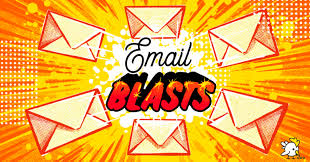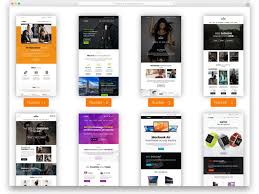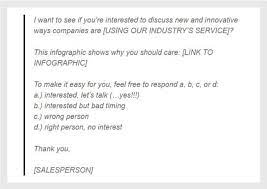Email blasts have become an increasingly popular marketing strategy for businesses of all sizes. An email blast is a mass email sent to a large number of subscribers at once, typically promoting a product, service, or event.
One of the main benefits of email blasts is that they are cost-effective. Unlike traditional forms of advertising such as television or radio ads, email blasts require minimal investment and can be sent to a large audience with just a few clicks. This makes them an attractive option for small businesses with limited marketing budgets.
Another advantage of email blasts is their ability to reach a targeted audience. By segmenting your email list based on demographics, interests, and behavior, you can ensure that your message is delivered to the people who are most likely to be interested in your product or service. This increases the chances of conversion and ultimately leads to higher sales.
Email blasts also provide measurable results. With tools like Google Analytics, you can track how many people opened your email, clicked on links within it, and made purchases as a result. This data allows you to refine your marketing strategy and tailor future emails to better meet the needs and preferences of your subscribers.
However, there are some potential downsides to consider when using email blasts as part of your marketing strategy. One risk is that recipients may view them as spam if they receive too many emails from you in a short period. To avoid this, it’s important to limit the frequency of your emails and ensure that each one provides value to the recipient.
Another challenge is ensuring that your emails stand out in crowded inboxes. To increase open rates and engagement with your emails, it’s important to use attention-grabbing subject lines and compelling content that resonates with your audience.
Overall, while there are risks associated with using email blasts as part of your marketing strategy, their benefits make them an attractive option for businesses looking to reach a large audience on a limited budget. By carefully crafting targeted, engaging emails and tracking their performance, businesses can use email blasts to drive sales and build brand awareness.
8 Benefits of Email Blasts: Low Cost, Targeted Messages, Immediate Results, and More
- Low cost
- Targeted messages
- Immediate results
- Easy tracking
- Accessibility
- Automation
- Personalization
- Brand building
5 Cons of Email Blasts: Impersonal, Blocked, Annoying, Unmeasurable, and Unread
- Spam filters can block emails from reaching the intended recipient.
- Email blasts can be perceived as impersonal and unprofessional.
- There is no guarantee that the recipient will open or read the email blast.
- Email blasts are often seen as intrusive and annoying by recipients, leading to a negative response or unsubscribing from future messages.
- It can be difficult to measure the success of an email blast campaign due to tracking issues and other factors.
Low cost
Email blasts have become a popular marketing strategy for businesses of all sizes, and one of the biggest advantages of this approach is its low cost. Compared to traditional forms of advertising like print or television, email blasts are an incredibly affordable way to reach a large audience.
One reason for this is that email marketing platforms are widely available and offer a range of pricing options to suit different business needs. Many platforms offer free plans for small businesses with limited budgets, while others charge based on the number of subscribers or emails sent. This means that businesses can choose a plan that fits their budget and scale up as they grow.
Another reason email blasts are so cost-effective is that they require minimal investment in terms of time and resources. With just a few clicks, businesses can send an email blast to thousands or even millions of subscribers at once. This makes it easy to reach a large audience quickly and efficiently without having to invest in expensive advertising campaigns.
Overall, the low cost of email blasts makes them an attractive option for businesses looking to promote their products or services on a budget. By carefully crafting targeted emails and using data analytics to track performance, businesses can use email blasts to drive sales and build brand awareness without breaking the bank.
Targeted messages
One of the biggest advantages of email blasts is the ability to tailor messages to specific groups of people. With email marketing, you can segment your audience based on demographics, interests, and past behavior to create targeted messages that resonate with your subscribers.
For example, if you have a list of customers who have purchased from you in the past, you can create an email blast that highlights new products or services that are similar to what they’ve bought before. This not only increases the chances of conversion but also shows your customers that you value their business and understand their needs.
Similarly, if you have a newsletter with different topics or categories, you can segment your subscribers based on their interests and send them relevant content. This not only increases engagement but also helps build a stronger relationship with your subscribers.
By tailoring your messages to specific groups of people, you can increase the effectiveness of your email blasts and improve the overall ROI of your marketing efforts. It shows that you understand your audience’s needs and preferences and are willing to cater to them.
Overall, targeted messages are a crucial aspect of email blasts that make them such an effective marketing tool. By using data-driven segmentation strategies and crafting personalized messages for each group, businesses can drive higher engagement rates and ultimately achieve better results from their email marketing campaigns.
Immediate results
One of the biggest advantages of email blasts is the immediate feedback they provide. Unlike other marketing strategies that can take days or even weeks to generate results, email blasts offer near-instant feedback from recipients.
When you send out an email blast, you can track how many people open your email, click on links within it, and even make purchases as a result. This data allows you to quickly analyze the effectiveness of your message and make adjustments as needed.
For example, if you notice that a large percentage of recipients are clicking on a particular link in your email, you may want to focus more on promoting that product or service in future emails. On the other hand, if few people are engaging with your message, you may need to rethink your approach and try a different strategy.
Immediate feedback also allows you to respond quickly to any issues or concerns raised by recipients. For example, if several people reply to your email with questions or complaints about a product, you can address those concerns promptly and prevent further damage to your brand reputation.
Overall, the ability to receive immediate feedback from email blasts is a valuable tool for businesses looking to refine their marketing strategies and improve their ROI. By analyzing data and responding quickly to feedback from recipients, businesses can create more effective campaigns that resonate with their audience and drive sales.
Easy tracking
One of the biggest advantages of using email blasts as a marketing strategy is the ease of tracking their effectiveness. With just a few clicks, you can see how many people opened your email and clicked through to your website, giving you valuable insights into how well your message is resonating with your audience.
This tracking ability allows you to make data-driven decisions about future marketing efforts. By analyzing which emails are most effective in terms of open rates and click-through rates, you can refine your messaging and tailor future emails to better meet the needs and preferences of your subscribers.
Additionally, tracking metrics such as conversion rates can help you determine the ROI of your email blasts. This information is invaluable in making decisions about where to allocate marketing resources and which campaigns are worth continuing.
Overall, the ease of tracking offered by email blasts makes them an attractive option for businesses looking to measure the effectiveness of their marketing efforts. By leveraging data insights to refine messaging and target audiences more effectively, businesses can use email blasts to drive sales and build brand awareness with confidence.
Accessibility
Email blasts have become a popular and cost-effective marketing strategy for businesses of all sizes. One of the main benefits of email blasts is their accessibility. Most people have access to email, which means that businesses can easily reach their target market with minimal effort or cost.
Unlike traditional forms of advertising such as television or radio ads, email blasts require minimal investment and can be sent to a large audience with just a few clicks. This makes them an attractive option for small businesses with limited marketing budgets.
Moreover, email is accessible to almost everyone these days. With the widespread use of smartphones and other mobile devices, people can check their emails anytime and anywhere. This makes it easier for businesses to reach their target market at any time and from any location.
Email blasts also allow businesses to reach a wider audience than other forms of advertising. By segmenting your email list based on demographics, interests, and behavior, you can ensure that your message is delivered to the people who are most likely to be interested in your product or service. This increases the chances of conversion and ultimately leads to higher sales.
In conclusion, email blasts are an accessible way for businesses to reach their target market with minimal effort or cost. With the widespread use of email today, it’s easier than ever before for businesses to connect with potential customers and build brand awareness through targeted email campaigns.
Automation
One of the biggest pros of using email blasts as part of your marketing strategy is the ability to automate certain aspects of the process. Automation can save you time and effort, while also ensuring that your emails are sent at the most effective times.
For example, you can schedule your email blasts to be sent out at specific times when your audience is most likely to be checking their inbox. This helps to increase open rates and engagement with your emails, ultimately leading to higher conversion rates.
Additionally, automation allows you to send out emails triggered by specific events. For instance, when someone signs up for your newsletter or makes a purchase on your website, an automated email can be sent out thanking them for their support and providing additional information about your products or services. This personalized touch helps to build a stronger relationship with your subscribers and customers.
Automation also allows you to segment your email list and send targeted messages based on specific criteria. For example, if a subscriber has shown interest in a particular product or service, you can send them an email promoting related offerings. This increases the chances of conversion and ultimately leads to higher sales.
Overall, automation is a powerful tool that can help businesses streamline their email marketing efforts while also delivering more personalized and effective messages to their subscribers. By taking advantage of this pro of email blasts, businesses can save time and effort while also achieving better results from their marketing campaigns.
Personalization
Personalization is a powerful tool in email marketing, and email blasts are no exception. With the ability to personalize emails with content that is relevant to each individual recipient, businesses can increase engagement and drive action from their subscribers.
By segmenting your email list based on factors such as demographics, interests, and past behavior, you can tailor your emails to the specific needs and preferences of each recipient. This could include personalized product recommendations based on past purchases or content recommendations based on their browsing history.
The result is a more targeted and relevant message that resonates with the recipient and increases the likelihood of them taking action on it. This could mean clicking through to your website, making a purchase, or sharing your message with others.
Personalization also helps build stronger relationships between businesses and their subscribers. By showing that you understand their needs and interests, you create a sense of trust and loyalty that can lead to long-term customer relationships.
Overall, personalization is a key advantage of email blasts that businesses should take advantage of. By using data-driven insights to personalize emails for each individual recipient, businesses can increase engagement, drive action, and build stronger relationships with their subscribers.
Brand building
Email blasts are a powerful tool for businesses looking to build their brand and establish long-term relationships with their customers. By providing helpful information and promotions through regular email communication, businesses can keep their customers engaged and informed, ultimately leading to increased loyalty and sales.
One key advantage of email blasts for brand building is that they allow businesses to stay top-of-mind with their customers. By sending regular emails with relevant content, businesses can remind their customers of the value they provide and reinforce their brand identity. This helps to build trust and credibility over time, making it more likely that customers will choose them over competitors.
Another benefit of email blasts for brand building is that they enable businesses to showcase their expertise and thought leadership in their industry. By providing helpful tips, insights, and advice on topics related to their products or services, businesses can position themselves as trusted advisors in the eyes of their customers. This not only builds credibility but also helps to differentiate them from competitors who may not offer the same level of expertise.
Finally, email blasts can be an effective way to promote new products or services and generate excitement around them. By offering exclusive promotions or early access to new offerings through email communication, businesses can create a sense of anticipation among their customers and drive sales.
Overall, email blasts are a valuable tool for building a strong brand identity and establishing lasting relationships with customers. By providing helpful information, showcasing expertise, and promoting new offerings through regular email communication, businesses can stay top-of-mind with their audience and ultimately drive loyalty and sales over time.
Spam filters can block emails from reaching the intended recipient.
One of the main cons of email blasts is the risk of having your emails blocked by spam filters. Spam filters are designed to prevent unwanted emails from reaching users’ inboxes by analyzing the content and sender information of each email. While this is a useful tool for protecting users from phishing scams and other malicious content, it can also lead to legitimate emails being blocked.
If your email is flagged as spam, it may be automatically sent to the recipient’s spam folder or blocked entirely. This means that even if you have a large email list, only a small percentage of your subscribers may actually receive your message.
To avoid having your emails blocked by spam filters, it’s important to follow best practices for email marketing. This includes avoiding certain trigger words and phrases that are commonly associated with spam, such as “free,” “act now,” and “limited time offer.” It’s also important to use a reputable email service provider that has a good reputation with ISPs and email clients.
Another way to avoid being flagged as spam is to obtain permission from your subscribers before sending them emails. This can be done through opt-in forms on your website or by asking customers to sign up for your newsletter at the point of sale. By obtaining explicit consent from your subscribers, you can ensure that they are interested in receiving your messages and less likely to mark them as spam.
In summary, while spam filters can be an obstacle for businesses using email blasts as part of their marketing strategy, there are steps that can be taken to minimize the risk of being flagged as spam. By following best practices for email marketing and obtaining permission from subscribers before sending emails, businesses can increase the chances of their messages reaching their intended audience.
Email blasts can be perceived as impersonal and unprofessional.
One of the biggest cons of email blasts is that they can be perceived as impersonal and unprofessional. When a subscriber receives an email that appears to be sent to a large group of people, it can feel like they are just one of many on a long list. This lack of personalization can make the recipient feel undervalued and less likely to engage with future emails.
Furthermore, since email blasts are often used by spammers and scammers, they can be viewed with suspicion by some recipients. This can lead to your email being marked as spam or even blocked entirely, preventing it from reaching its intended audience.
To avoid these issues, it’s important to ensure that your email blasts are personalized and tailored to the interests and preferences of your subscribers. This can be achieved through segmentation based on demographics, behavior, and interests. Additionally, including the recipient’s name in the subject line or greeting can help create a more personal connection.
It’s also important to ensure that your emails are well-written and professional in tone. Avoid using slang or overly casual language that may come across as unprofessional. Proofreading your emails for spelling and grammatical errors is also essential for creating a positive impression.
In conclusion, while email blasts can be an effective marketing tool, their impersonal nature means that they may not always be well-received by subscribers. By taking steps to personalize your emails and maintain a professional tone, you can mitigate this con and increase engagement with your audience.
There is no guarantee that the recipient will open or read the email blast.
One of the biggest cons of email blasts is that there is no guarantee that the recipient will open or read the email. Despite careful segmentation and crafting of attention-grabbing subject lines, some recipients may simply delete the email without ever opening it.
This lack of engagement can be frustrating for businesses who have invested time and resources into creating a compelling email blast. It can also lead to lower conversion rates and ultimately impact sales.
To address this issue, businesses can take steps to increase the chances that their emails are opened and read. This includes personalizing emails with the recipient’s name, using a clear and concise subject line, and providing valuable content that meets the needs and interests of the recipient.
Another strategy is to segment your email list even further based on engagement levels. By identifying subscribers who consistently open and engage with your emails, you can create a separate list for them and tailor future emails specifically to their preferences. This increases the likelihood that they will continue to engage with your brand in the future.
While there is no guarantee that every recipient will open or read your email blast, taking steps to increase engagement can help improve overall performance and drive sales. By focusing on personalization, value, and segmentation, businesses can optimize their email blasts for maximum impact.
Email blasts are often seen as intrusive and annoying by recipients, leading to a negative response or unsubscribing from future messages.
While email blasts can be an effective marketing tool, they also have their downsides. One of the main drawbacks is that they can be seen as intrusive and annoying by recipients. When people receive too many emails from a company, they may feel overwhelmed and frustrated, leading to a negative response or even unsubscribing from future messages.
This is especially true if the content of the email blast is not relevant or interesting to the recipient. If someone receives an email promoting a product or service that they have no interest in, they are likely to view it as spam and may even mark it as such. This can damage the sender’s reputation and lead to future emails being automatically filtered into spam folders.
To avoid this con of email blasts, it’s important to ensure that each message provides value to the recipient. This can be achieved by segmenting your email list based on demographics, interests, and behavior and tailoring your content accordingly. By providing relevant information and offers that are tailored to each subscriber’s needs and preferences, you can increase engagement and reduce the risk of negative responses.
Another way to avoid being seen as intrusive is by limiting the frequency of your email blasts. Sending too many emails in a short period can overwhelm subscribers and lead them to unsubscribe or mark your messages as spam. Instead, aim for a consistent schedule that provides value without overwhelming your audience.
In conclusion, while email blasts can be an effective marketing tool, it’s important to be aware of their potential downsides. By providing relevant content and limiting frequency, businesses can avoid being seen as intrusive or annoying by their subscribers and instead build positive relationships with their audience.
It can be difficult to measure the success of an email blast campaign due to tracking issues and other factors.
One of the main challenges associated with email blasts as a marketing strategy is measuring their success. While email blasts are cost-effective and allow businesses to reach a large audience, tracking their impact can be difficult due to a variety of factors.
One issue is that not all email clients support tracking pixels, which are small images embedded in emails that allow marketers to track open rates and other metrics. This can make it difficult to accurately measure how many people opened an email and engaged with its content.
Another factor is that recipients may have different settings on their email clients that prevent tracking or automatically mark emails as spam. This can lead to inaccurate data and make it challenging to determine the true effectiveness of an email blast campaign.
Additionally, other factors such as the timing of the email blast, the quality of the content, and the relevance of the message to the recipient can all impact its success. It’s important for businesses to carefully consider these factors when planning an email blast campaign and continuously monitor and adjust their strategy based on performance data.
Despite these challenges, there are ways for businesses to improve their ability to measure the success of an email blast campaign. One approach is to use A/B testing, where different versions of an email are sent to different segments of your audience in order to determine which one performs better. Another approach is to use tools like Google Analytics or other marketing automation software that provide more detailed insights into how your emails are performing.
In conclusion, while measuring the success of an email blast campaign can be challenging due to tracking issues and other factors, there are ways for businesses to overcome these obstacles and gain valuable insights into how well their campaigns are performing. By carefully monitoring performance data and continuously refining their strategy, businesses can use email blasts as a powerful tool for driving sales and building brand awareness.




